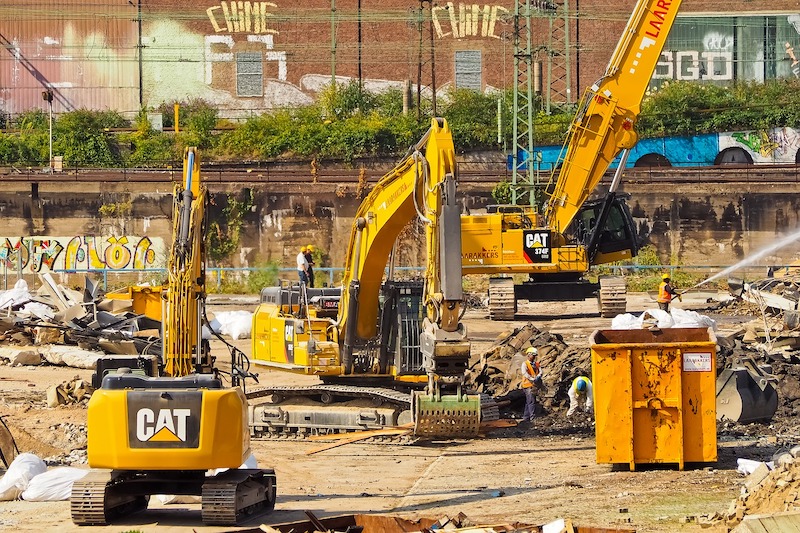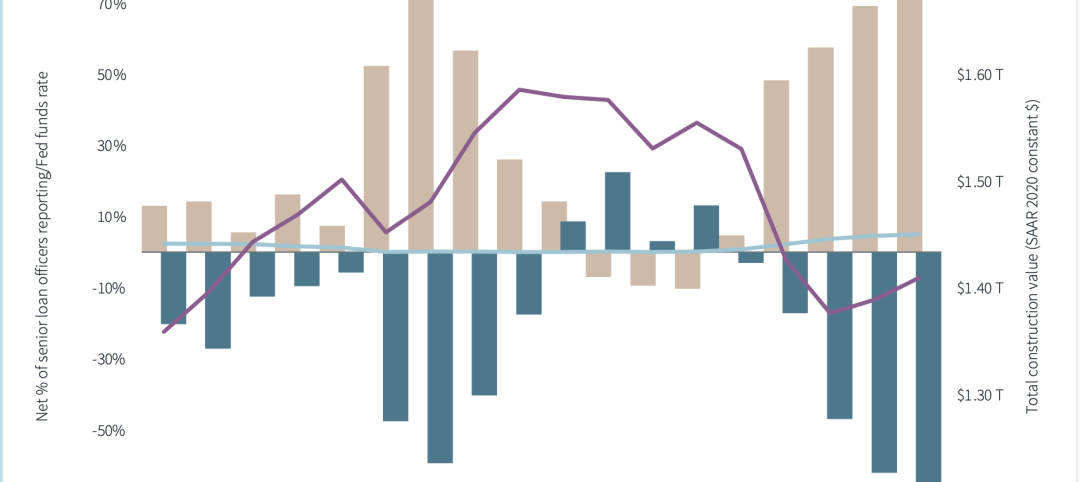Data from the first quarter U.S. Chamber of Commerce Commercial Construction Index reveals contractors are growing more optimistic, mostly driven by a rise in revenue expectations. They also have better outlooks on hiring and equipment spending plans as business concerns related to the coronavirus pandemic lessen.
In the first quarter of this year, 36% of contractors expect their revenue to increase over the next year, a jump of 11 percentage points from 25% in Q4 2020. Eighty-seven percent expect their revenue to either stay the same or increase, up from 86% last quarter. Most (86%) contractors also report a moderate to high level of confidence that the U.S. market will provide enough new business in the next year. Nearly a quarter (24%) report a high level of confidence, up from 19% in Q4 2020.
Hiring plans are also positive as close to half (46%) of contractors say they will employ more people in the next six months, up from 37% in Q4 2020. The same percentage (46%) expect to keep the same number of workers, and just 3% expect to reduce their staffing, down from 12% in Q4 2020.
“As vaccines continue to roll out, contractors are expecting to hire more workers and anticipating good times ahead. The industry still has a way to go to return to pre-pandemic levels, but rising optimism in the commercial construction industry is a positive sign for the broader economy,” said U.S. Chamber of Commerce Executive Vice President and Chief Policy Officer Neil Bradley. “However, finding skilled workers was a critical issue before the pandemic, and while it has remained a chronic problem over the last year, heightened concern may be emerging again as contractors look to hire. The U.S. Chamber is committed to supporting businesses in retraining and making sure the economy has the skilled workforce it needs.”
The boost in revenue expectations drove a three-point rise in this quarter’s overall Index score to 62 from 59 in Q4 2020. The score for revenue expectations, one the Index’s three leading indicators, jumped five points to 57, while contractors’ confidence in new business opportunities rose two points to 59. Despite the gains, the Index remains 12 points below its score of 74 from Q1 2020 before the pandemic.
Skilled Worker Shortage Causes Ongoing Challenges
Alongside the positive signs of recovery come workforce challenges. This quarter, 85% of contractors report moderate to high levels of difficulty finding skilled workers, up from 83% in Q4 2020. Of those, 45% report a high level of difficulty, up from 42% last quarter, but still down 10 percentage points year-over-year from 55% in Q1 2020 before the pandemic.
Meanwhile, 88% report a moderate to high degree of concern about their workers having adequate skill levels. Forty-six percent report a high degree of concern, up from 36% in Q4 2020. Almost all (94%) contractors who reported a moderate to high degree of concern expect the problem with workers having adequate skill levels will stay the same or get worse in the next six months.
Lumber Concerns Ease, Cost Fluctuation Concerns Rise
Similar to last quarter, 71% of contractors say they face at least one material shortage. Of those, 22% are experiencing a shortage of wood/lumber (down from 31% in Q4 2020), followed by steel (14%), and pipe/PVC (10%).
This quarter, more (82%) contractors say cost fluctuations have a moderate to high impact on their business, up eight percentage points from Q4 2020, and up 17 percentage points year-over-year. Of those experiencing the impact of cost fluctuations, 43% said wood/ lumber is the product of most concern (down from 61% in Q4 2020), followed by steel (35%), and copper (27%).
Additional findings:
— Tariff and trade concerns are up. More (35%) contractors say steel and aluminum tariffs will have a high to very high degree of impact on their business in the next three years, up from 24% saying the same in Q4 2020.
— 37% of contractors plan to increase spending on tools and equipment, increasing from 28% in Q2 2020. Before the pandemic (Q1 2020), 54% said they planned to increase spending.
— 80% of contractors are still experiencing delays due to COVID-19, with an average share of 23% of their projects delayed, but that share is expected to drop to 15% looking ahead six months.
— 58% say worker health and safety remains a top concern for their business, followed by more project shutdowns/delays (50%), fewer projects (35%), and less availability of building products (33%).
The Index comprises three leading indicators to gauge confidence in the commercial construction industry, generating a composite Index on the scale of 0 to 100 that serves as an indicator of health of the contractor segment on a quarterly basis.
The Q1 2021 results from the three key drivers are:
— Revenue: Contractors’ revenue expectations over the next 12 months increased to 57 (up five points from Q4 2020).
— New Business Confidence: The overall level of contractor confidence increased to 59 (up two points from Q4 2020).
— Backlog: This indicator remained steady from Q4 2020 at 69.
The research was developed with Dodge Data & Analytics (DD&A), the leading provider of insights and data for the construction industry, by surveying commercial and institutional contractors.
Note: In last quarter’s report, released on December 10, 2020, the overall index score and backlog component score were incorrectly reported due to a data tallying error. The correct overall index score for Q4 2020 was 59 (originally reported as 60). The correct score for backlog was 69 (originally reported as 70).
Related Stories
Contractors | Nov 1, 2023
Nonresidential construction spending increases for the 16th straight month, in September 2023
National nonresidential construction spending increased 0.3% in September, according to an Associated Builders and Contractors analysis of data published today by the U.S. Census Bureau. On a seasonally adjusted annualized basis, nonresidential spending totaled $1.1 trillion.
Market Data | Oct 23, 2023
New data finds that the majority of renters are cost-burdened
The most recent data derived from the 2022 Census American Community Survey reveals that the proportion of American renters facing housing cost burdens has reached its highest point since 2012, undoing the progress made in the ten years leading up to the pandemic.
Contractors | Oct 19, 2023
Crane Index indicates slowing private-sector construction
Private-sector construction in major North American cities is slowing, according to the latest RLB Crane Index. The number of tower cranes in use declined 10% since the first quarter of 2023. The index, compiled by consulting firm Rider Levett Bucknall (RLB), found that only two of 14 cities—Boston and Toronto—saw increased crane counts.
Market Data | Oct 2, 2023
Nonresidential construction spending rises 0.4% in August 2023, led by manufacturing and public works sectors
National nonresidential construction spending increased 0.4% in August, according to an Associated Builders and Contractors analysis of data published today by the U.S. Census Bureau. On a seasonally adjusted annualized basis, nonresidential spending totaled $1.09 trillion.
Giants 400 | Sep 28, 2023
Top 100 University Building Construction Firms for 2023
Turner Construction, Whiting-Turner Contracting Co., STO Building Group, Suffolk Construction, and Skanska USA top BD+C's ranking of the nation's largest university sector contractors and construction management firms for 2023, as reported in Building Design+Construction's 2023 Giants 400 Report. Note: This ranking includes revenue for all university/college-related buildings except student residence halls, sports/recreation facilities, laboratories, S+T-related buildings, parking facilities, and performing arts centers (revenue for those buildings are reported in their respective Giants 400 ranking).
Construction Costs | Sep 28, 2023
U.S. construction market moves toward building material price stabilization
The newly released Quarterly Construction Cost Insights Report for Q3 2023 from Gordian reveals material costs remain high compared to prior years, but there is a move towards price stabilization for building and construction materials after years of significant fluctuations. In this report, top industry experts from Gordian, as well as from Gilbane, McCarthy Building Companies, and DPR Construction weigh in on the overall trends seen for construction material costs, and offer innovative solutions to navigate this terrain.
Data Centers | Sep 21, 2023
North American data center construction rises 25% to record high in first half of 2023, driven by growth of artificial intelligence
CBRE’s latest North American Data Center Trends Report found there is 2,287.6 megawatts (MW) of data center supply currently under construction in primary markets, reaching a new all-time high with more than 70% already preleased.
Contractors | Sep 12, 2023
The average U.S. contractor has 9.2 months worth of construction work in the pipeline, as of August 2023
Associated Builders and Contractors' Construction Backlog Indicator declined to 9.2 months in August, down 0.1 month, according to an ABC member survey conducted from Aug. 21 to Sept. 6. The reading is 0.5 months above the August 2022 level.
Contractors | Sep 11, 2023
Construction industry skills shortage is contributing to project delays
Relatively few candidates looking for work in the construction industry have the necessary skills to do the job well, according to a survey of construction industry managers by the Associated General Contractors of America (AGC) and Autodesk.
Market Data | Sep 6, 2023
Far slower construction activity forecast in JLL’s Midyear update
The good news is that market data indicate total construction costs are leveling off.

















